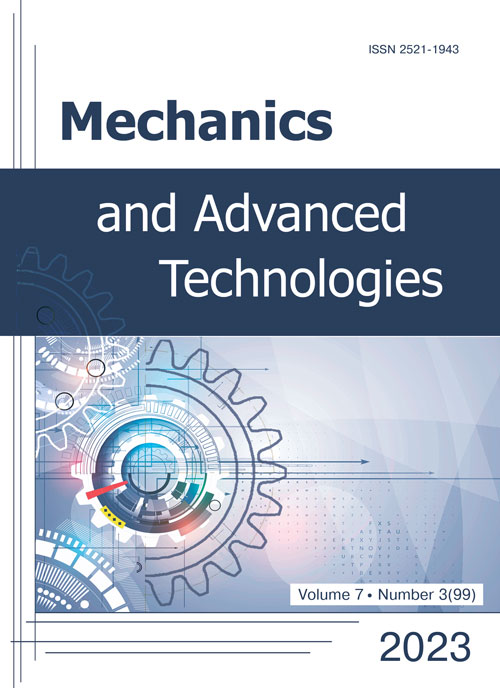Directed circulating flows in tanks of moving objects
DOI:
https://doi.org/10.20535/2521-1943.2023.7.3.291259Keywords:
fuel tank, inertial fluid flows, hydrodynamic fields, numerical modeling, circulations, accompanying wake of the guidance apparatusAbstract
The results of liquid fuel inertial flows numerical modeling in the tanks of the spacecraft during its maneuvering in the Earth's orbit are given. It is shown that the circulations that occur when internal guiding devices are used in the form of widely spaced rigid baffles can be deformed and affect the flow space not covered by them. In addition, the circular moments of inertia of the liquid on the baffles can be controlled by means of the appropriate location of the guide devices in terms of width and distance from the tank wall.
The force effects calculation of the moving fluid on the walls and internal structures makes it possible to fairly correctly present the hydrodynamic picture of the of inertial flows development, as well as predict the methods and means of compensation for such disturbances. According to the obtained results of the specified processes simulation in the tanks, it can be stated that the inertial flows of the liquid in the tanks are strongly nonlinear, the properties of which depend on the geometry, the initial conditions for the generation of peak force effects tank on the tank walls and bottoms.
The use of internal guiding devices in the flow significantly changes the geometry of wave formations, corrects the coordinates and duration of resonant currents in the tank. The main task is to minimize the mass and dimensions of the baffles with a simultaneous increase in the damping efficiency of resonant flows. In addition, the determination of the power parameters real distribution contributes to the development of the latest, more effective designs of baffles, which will allow more reliable influence on uncontrolled inertial flows in tanks.
References
- K. Kolesnikov, Dinamіka raket. Moskva: Mashinostroyeniye, 1980, 376 p.
- G. Mikishev, Eksperimentalnye metody v dinamike kosmicheskogo apparata. Moskva: Mashinostroyeniye, 1978, 248 p.
- H. Grinspen, Teoriya vrashchayushchikhsya zhidkostey. Leningrad: Gidrometeoizdat, 1975, 304 p.
- V. Kovalev, “Vliyanie vnutribakovykh peregorodok na techenie zhidkogo topliva v bakakh kosmicheskogo apparata”, Vestnik NTUU “KPI”, seriya Mashinostroyeniye, no. 48, pp. 73–79, 2006.
- V. Kovalev, “Opredeleniye gidrodinamicheskogo soprotivleniya stabilizatorov v toplivnykh bakakh kosmicheskogo letatelnogo apparata”, Vestnik NTUU “KPI”, seriya Mashinostroyeniye, vol. 1, no. 42, pp. 107–111, 2002.
- E. V. Bruyatskiy, A. G. Kostin and E. I. Nikiforovich, “Vikhrevaya struktura potoka v ploskom kanale pri nalichii na ego stenke kvadratnogo prepyatstviya”, Vіsnik Donetskogo Natsіonalnogo unіversitetu, serіya A: Pryrodnychi nauky, no. 2. pp. 42–50, 2011.
- X. Zheng, Y. You, Q.Ma, A. Khayyer and S. Shao, “A Comparative Study on Violent Sloshing with Complex Baffles Using the ISPH Method”, Appl. Sci., vol. 8, no. 6, p. 904, 2018. DOI: https://doi.org/10.3390/app8060904.
- E. Zhang, W. Zhu and L. Wang, “Influencing analysis of different baffle factors on oil liquid sloshing in automobile fuel tank”, Proceedings of the Institution of Mechanical Engineers, Part D: Journal of Automobile Engineering, vol. 234, no. 13, pp. 3180-3193, 2020. DOI: https://doi.org/10.1177/0954407020919584.
- R. Belakroum, M. Kadja, T. H. Mai and C. Maalouf, “An efficient passive technique for reducing sloshing in rectangular tanks partially filled with liquid”, Mechanics Research Communications, vol. 37, no. 3, pp. 341–346, 2010. DOI: https://doi.org/10.1016/j.mechrescom.2010.02.003.
- L. Ren, Y. Zou, J. Tang, X. Jin, D. Li and M. Liu, “Numerical Modeling of Coupled Surge-Heave Sloshing in a Rectangular Tank with Baffles”, Shock and Vibration, vol. 2021, no. 1, pp. 1-11, 2021. DOI: https://doi.org/10.1155/2021/5545635.
Downloads
Published
How to Cite
Issue
Section
License
Copyright (c) 2023 Василь Ковальов

This work is licensed under a Creative Commons Attribution 4.0 International License.
Authors who publish with this journal agree to the following terms:
- Authors retain copyright and grant the journal right of first publication with the work simultaneously licensed under CC BY 4.0 that allows others to share the work with an acknowledgement of the work's authorship and initial publication in this journal.
- Authors are able to enter into separate, additional contractual arrangements for the non-exclusive distribution of the journal's published version of the work (e.g., post it to an institutional repository or publish it in a book), with an acknowledgement of its initial publication in this journal.
- Authors are permitted and encouraged to post their work online (e.g., in institutional repositories or on their website) prior to and during the submission process, as it can lead to productive exchanges, as well as earlier and greater citation of published work











